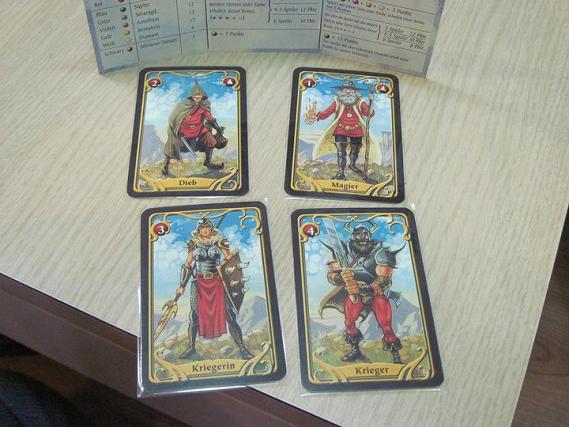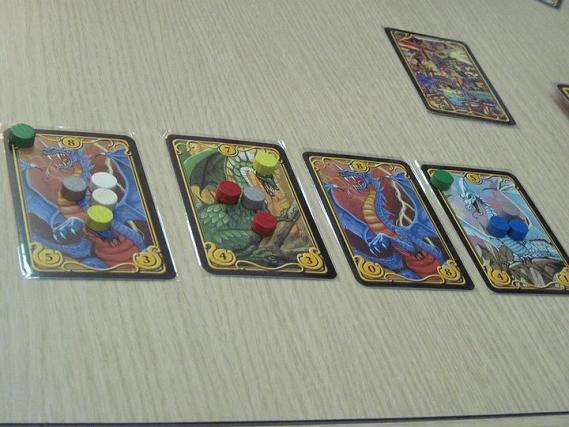
This is smallish negotiation-based game that we played recently. I don’t think it’s very notable and wouldn’t have written about it if not for a very odd card effect that Shan used. I discovered later from BGG that this isn’t the only odd card effect in the game. I was also amused to find after the fact that Dragon’s Gold was indeed designed by Bruno Faidutti as it felt very much like his style when I played it.
In this game, each player controls a set of four adventurers and must steal jewels from dragons. Both dragons and adventurers are represented by cards and each has a strength rating. To defeat a dragon, the players must simply assign enough adventurers to it such that the adventurers’ combined strength equals or exceeds that of the dragon. In addition, each dragon card has two more numbers on it. One shows how many jewels (colored markers) must be drawn from the drawstring bag to be placed on the card as a reward. The other shows how many additional jewels need to be drawn when the dragon is actually defeated.
Each player starts with all four of his adventurer cards face up. During his turn, he must assign one of his face-up adventurers to one of the dragons on the board. When a dragon is defeated, all adventurer cards assigned to it are returned to their owners face-down. When a player’s turn arrives and all he has are face-down cards, he may turn all of them face-up. Play continues until all jewels have been distributed.

A few things complicate this relatively straightforward setup. First, the scoring system for the jewels ensures that some colors will be more useful to some players than others. Gold is worth a flat 3 points each, which makes them desirable to anyone while silver is worth a flat 1 point each. Red is also worth 1 point each, but if you get it while you have a mage assigned to that dragon, you also get to draw a magic card which is how all the weird effects come in. The other five colors are worth nothing on their own, unless you manage to get a majority in that color. You also get points for each set of these five colors that you manage to complete. Finally there is a single black diamond that is worth a lot of points but nullifies the values of the sets of five colors.
When a dragon is killed, all players who contributed adventurers must negotiate over how to distribute its treasures and they must reach an agreement within one minute, as measured using the provided hourglass, or forfeit all the jewels. Players who contributed a thief into the mix also get to steal one jewel from any other player involved in the negotiations. All jewels are hidden behind a screen so that you don’t know what everyone else has, though the screens are too awkwardly small to be very practical.
Anyway in our game, Shan basically ran away with the game because she drew and used a wicked magic card for nearly the whole game. This was the “Invisible Hand” which allowed the owner to steal jewels from undefeated dragons for as long as the thefts remain undetected. Not knowing that such a card existed, we didn’t realize someone was stealing the jewels for the whole game though a couple of times, we noticed that the dragon cards had less treasure than they should have but thought it was a mistake when we placed them. Sean admitted afterwards that he had known this card existed but had completely forgotten about it and so neglected to warn us.

The other weird effect that I learned of from BGG was some kind of confusion effect. After a deal has been made to split the treasure, you can play that card whether or not you’re involved in the negotiations. Then two players of your choice must exchange whatever it is that they originally agreed on. So you can agree to take nothing and have the other player take everything, then play the card to get everything instead. It’s sick and like the “Invisible Hand” card sort of ruins the game unless the players know enough to watch out for it.
The combination of time-limited negotiations and memorization didn’t really agree with me. Even Shan, though she was delighted that her thievery worked so well, didn’t like the game. There were some amusing moments, such as when Ah Fatt refused all deals and wanted all the jewels on a particular dragon to be lost, much to the consternation of the other players involved. But mostly the game was notable only for the novelty of the card effects.
Leave a Reply